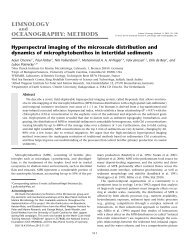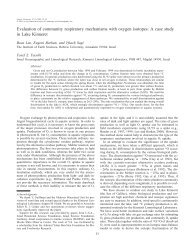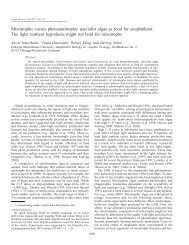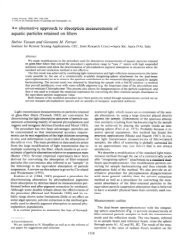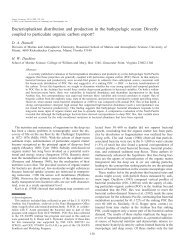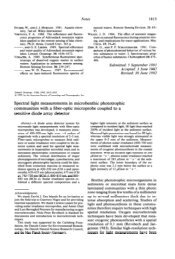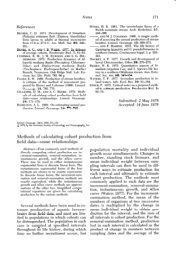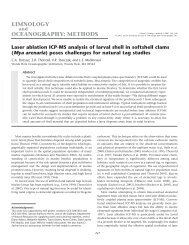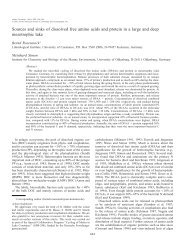Tina van de Flierdt, Katharina Pahnke, and GEOTRACES ... - ASLO
Tina van de Flierdt, Katharina Pahnke, and GEOTRACES ... - ASLO
Tina van de Flierdt, Katharina Pahnke, and GEOTRACES ... - ASLO
Create successful ePaper yourself
Turn your PDF publications into a flip-book with our unique Google optimized e-Paper software.
<strong>van</strong> <strong>de</strong> <strong>Flierdt</strong> et al. Seawater Nd Isotopes: Intercalibration<br />
intercalibration efforts for dissolved Nd isotopes, which inclu<strong>de</strong><br />
a total of 15 participating laboratories, some of which have a<br />
long-st<strong>and</strong>ing history of seawater Nd isotope measurements,<br />
<strong>and</strong> some of which are relatively new to the field.<br />
Although not one of the key parameters of the <strong>GEOTRACES</strong><br />
program, the REE concentrations in seawater have been historically<br />
used by a large number of laboratories to <strong>de</strong>cipher lateral<br />
<strong>and</strong> vertical processes in the water column as well as water<br />
mass provenance (e.g., El<strong>de</strong>rfield <strong>and</strong> Greaves 1982; Piepgras<br />
<strong>and</strong> Jacobsen 1992; Alibo <strong>and</strong> Nozaki 1999). We therefore used<br />
the opportunity offered by the Nd isotope study to gather<br />
intercalibration data on dissolved rare earth element concentrations<br />
(REEs), as well as Nd isotopic compositions <strong>and</strong> REE<br />
concentrations from marine particles.<br />
Our goal was to assess the precision <strong>and</strong> accuracy possible<br />
for dissolved <strong>and</strong> particulate Nd isotopes (<strong>and</strong> REEs). Following<br />
documentation <strong>and</strong> assessment of the data, we will present<br />
some recommendations to achieve precise <strong>and</strong> accurate<br />
results on future <strong>GEOTRACES</strong> cruises. This article is accompanied<br />
by a second article that takes a closer look at the seagoing<br />
si<strong>de</strong> of achieving accurate <strong>and</strong> precise results for dissolved<br />
<strong>and</strong> particulate Nd isotopes <strong>and</strong> REE, by presenting results on<br />
systematic tests on different materials <strong>and</strong> methods involved<br />
(<strong>Pahnke</strong> et al. 2012). The second article also presents the first<br />
<strong>GEOTRACES</strong> baseline profiles for Nd isotopes (<strong>and</strong> REEs) for<br />
the Bermuda Atlantic Time-Series Station (BATS) in the NW<br />
Atlantic Ocean <strong>and</strong> the SAFe station (Sampling <strong>and</strong> Analysis of<br />
Fe) in the Pacific Ocean.<br />
Materials <strong>and</strong> procedures<br />
Shipboard sampling of seawater <strong>and</strong> particles<br />
Samples used during this intercalibration exercise were collected<br />
on two <strong>GEOTRACES</strong> intercalibration cruises, carried out<br />
on the R/V Knorr in June-July 2008 in the Atlantic Ocean<br />
(Bermuda-Norfolk, KN193-6), <strong>and</strong> in May 2009 in the Pacific<br />
Ocean (Honolulu-San Diego, KN195-8). The two cruises were<br />
chosen to sample fundamentally different water masses <strong>and</strong><br />
biogeochemical regimes <strong>and</strong> to occupy previously well characterized<br />
time-series stations in the Atlantic Ocean (BATS) <strong>and</strong><br />
the Pacific Ocean (SAFe).<br />
For intercalibration of Nd isotopes <strong>and</strong> REE concentrations,<br />
both dissolved <strong>and</strong> particulate samples were collected. For dissolved<br />
samples, large volumes of filtered <strong>and</strong> homogenized<br />
seawater were collected from three different locations: BATS<br />
<strong>de</strong>ep water (2000 m), BATS sub-surface water (15 m), <strong>and</strong> SAFe<br />
<strong>de</strong>ep water (3000 m). Deep water samples were collected using<br />
multiple casts of the trace metal clean <strong>GEOTRACES</strong> rosette<br />
<strong>de</strong>ployed on a Kevlar hydroline, whereas sub-surface water<br />
was collected using the UCSC <strong>de</strong>signed “GeoFish” towed sampling<br />
system. Filtration of seawater was carried out using 0.2<br />
µm Osmonics cartridge filters in a portable clean <strong>van</strong> environment.<br />
Water from the same water <strong>de</strong>pth was transferred<br />
through Teflon tubing into two interconnected 500 L tanks<br />
ma<strong>de</strong> of fluorinated low <strong>de</strong>nsity polyethylene, which were<br />
236<br />
homogenized using an all PFA Teflon diaphragm pump (UCSC<br />
SAFe tanks). Homogenized 500-1000 L of seawater were acidified<br />
to pH < 2 using ultrapure Seastar HCl. Individual sample<br />
containers ranged from 0.5 L to 20 L, <strong>and</strong> were provi<strong>de</strong>d <strong>and</strong><br />
precleaned by the individual intercalibration participants.<br />
Overall, most laboratories received 2 ¥ 10 L seawater from<br />
each of the three locations for duplicate analyses of Nd isotopes,<br />
<strong>and</strong> 0.5 L of seawater for REE concentration measurements.<br />
Filling of individual sample containers was performed<br />
directly from the SAFe tanks un<strong>de</strong>r a tent on <strong>de</strong>ck the<br />
R/V Knorr.<br />
Particle samples were <strong>de</strong>rived from the three following<br />
locations: BATS <strong>de</strong>ep water (2000 m), BATS sub-surface water<br />
(30 m), <strong>and</strong> Virgina slope water (98 m). Two complementary<br />
pumping systems were <strong>de</strong>ployed for Nd isotope <strong>and</strong> REE intercalibration<br />
purposes: McLane pumps (<strong>de</strong>ep water location at<br />
BATS), <strong>and</strong> MULVFS (Multiple Unit Large Volume Filtration<br />
System; other two location) (Maiti et al. 2012; Bishop et al.<br />
2008). Using the McLane pumps, about 600 L seawater were<br />
pumped through each 0.45 µm Supor filter (142 mm diameter).<br />
Filters were dried onboard in a <strong>de</strong>dicated clean environment,<br />
<strong>and</strong> cut into halves using a PVC template fitted with a<br />
ceramic knife (pie-cutter). Each laboratory participating in the<br />
Nd isotope intercalibration was provi<strong>de</strong>d half of a filter <strong>and</strong><br />
half of a corresponding dipped blank. For REE intercalibration,<br />
2 cm punches, corresponding to ~20 L pumped seawater, were<br />
taken out of a few of the filter halves for REE measurements<br />
(e.g., some of the isotope laboratories received slightly smaller<br />
samples). Larger water volumes (>1000 L) were pumped with<br />
the MULVFS system, equipped with large quartz fiber filters<br />
(QMA; 506.7 cm 2 area, 1 µm pore size). Four 4.5 cm punches<br />
were taken out of the filters for Nd isotope samples, representing<br />
~380 L pumped water volume, accompanied by two<br />
2.5 cm punches from dipped blanks. For REE measurements,<br />
four 1.2 cm punches (~27 L pumped water volume) were collected<br />
from dried filters together with two 1.2 cm punches<br />
from dipped blanks. All filters were stored <strong>and</strong> shipped in precleaned<br />
containers.<br />
Shore-based methods to <strong>de</strong>termine dissolved <strong>and</strong> particulate<br />
Nd isotopic compositions <strong>and</strong> REE concentrations<br />
As this article documents the first intercalibration effort for<br />
Nd isotopes (<strong>and</strong> REE concentrations) in seawater <strong>and</strong> marine<br />
particles, no particular analytical method was prescribed. This<br />
approach allowed a variety of routine procedures to be compared<br />
(e.g., different sample preconcentration, ion chromatography,<br />
<strong>and</strong> mass spectrometry procedures). Below we<br />
briefly summarize the main differences in the analytical methods<br />
applied. Methodological information for each<br />
anonymized laboratory can be found in Tables 1a <strong>and</strong> 1b.<br />
Neodymium isotope measurements in seawater samples<br />
To preconcentrate Nd from the seawater matrix most laboratories<br />
performed a Fe coprecipitation step, where Fe is ad<strong>de</strong>d<br />
to seawater, most typically as FeCl 3 <strong>and</strong> equilibrated for 24-48<br />
h. A subsequent increase to a pH of ~8, using ultraclean




